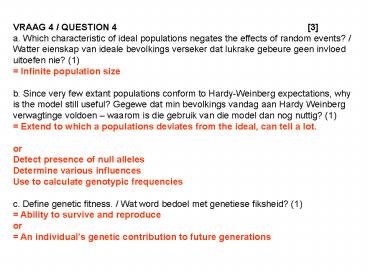VRAAG 4 QUESTION 43 PowerPoint PPT Presentation
1 / 8
Title: VRAAG 4 QUESTION 43
1
VRAAG 4 / QUESTION 4 3 a. Which
characteristic of ideal populations negates the
effects of random events? / Watter eienskap van
ideale bevolkings verseker dat lukrake gebeure
geen invloed uitoefen nie? (1) Infinite
population size b. Since very few extant
populations conform to Hardy-Weinberg
expectations, why is the model still useful?
Gegewe dat min bevolkings vandag aan Hardy
Weinberg verwagtinge voldoen waarom is die
gebruik van die model dan nog nuttig? (1)
Extend to which a populations deviates from the
ideal, can tell a lot. or Detect presence of
null alleles Determine various influences Use to
calculate genotypic frequencies c. Define
genetic fitness. / Wat word bedoel met genetiese
fiksheid? (1) Ability to survive and
reproduce or An individuals genetic
contribution to future generations
2
VRAAG 5 / QUESTION 5 5 Describe the
relationship between sickle cell anemia and
malaria. What kind of selection is involved? /
Beskryf die verwantskap tussen sekel-sel anemie
en malaria. Watter vorm van seleksie is hier ter
sprake? AA Healthy red blood cells, totally
susceptible to malaria 1 Aa Moderately
anemic 1 / moderate resistance to malaria
1 aa anemic, total resistance to malaria
1 stabilizing selection 1 (Natural
selection ½ ) also marks for some
background on the mechanism of resistance
3
VRAAG 6 / QUESTION 6 3 Elephant in the
Pilansberg National Park are completely isolated
from other elephant populations. During an
artificial translocation program, 22 new
elephants (from the Kruger National Park) are
added to the existing population. With this
action, it is hoped to mimic migration to the
otherwise isolated gene pool. At a given gene
locus, the frequency of allele A is 0.53 in the
established Pilansberg population, and 0.79 in
the new additions. What will the frequency of A
in Pilansberg be after one generation, if the
addition of 22 animals is equivalent to m 0.09?
/ Die olifant bevolking in die Pilansberg
Nasionale Park is heeltemal geïsoleerd van ander
olifant bevolkings. n Totaal van 22 olifante uit
die Kruger wildtiun word na Pilansberg verskuif,
in n poging om migrasie na die geïsoleerde
bevolking na te boots. By n gegewe lokus is die
frekwensie van alleel A 0.53 in die
Pilansberg-bevolking en 0.79 in die nuwe
aankomelinge. Wat sal die frekwensie van A in die
Pilansberg-bevolking wees na een generasie,
indien die 22 olifante n migrasie tempo van m
0.09 verteenwoordig? Optional Total then
calculated x / 17 or x / 20 P1 (1-m)pi
mpm m 0.09 pi 0.53 pm 0.79 P1
(1-0.09)(0.53) 1 (0.09)(0.79) 1 0.482
0.071 0.553 1
4
VRAAG 7 / QUESTION 7 9 An isolated
springbok population of 109 animals is found on
the Calmsford Nature Reserve. A genetic study
reveals that, at a given locus, 71 animals have
the genotype AA, 28 individuals are heterozygous
and the remaining 10 are homozygous for the
recessive allele. Are genotypes in this
population in Hardy Weinberg equilibrium? Assume
a critical value of 3.85 for the X2 test. / n
Geïsoleerde bevolking van 109 springbokke kom
voor op die Chalmsford Natuurreservaat. n
Genetiese studie toon dat 71 diere die genotipe
AA besit by n gegewe geen lokus, 28 is
heterosigote en die oorblywende 10 is
homosigoties vir die resessiewe alleel. Is
genotipes by hierdie lokus in Hardy Weinberg
ekwilibrium? Neem aan die kritieke waarde vir die
X2 toets is 3.84.
Remember to list ALL steps NB decimal
places (do not round numbers too much) And
beware of calculation errors
5
Genotypic frequencies
Allele frequencies
6
And actual expected numbers for each genotype
Expected frequency of genotype AA p²
(0.78)² 0.608 x 109 ½ 66.32 ½
Expected frequency of genotype Aa 2pq
2(0.78)(0.22) 0.343 x 109 ½
37.41 ½
Expected frequency of genotype aa q²
(0.22)² 0.048 x 109 ½ 5.28 ½
7
(No Transcript)
8
X2 critical 3.84 X2 calculated
6.92 6.92 is larger than 3.84 1
The null-hypothesis - observed genotypic
frequencies do not differ from expected genotypic
frequencies is rejected.

